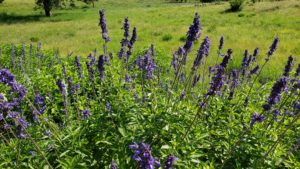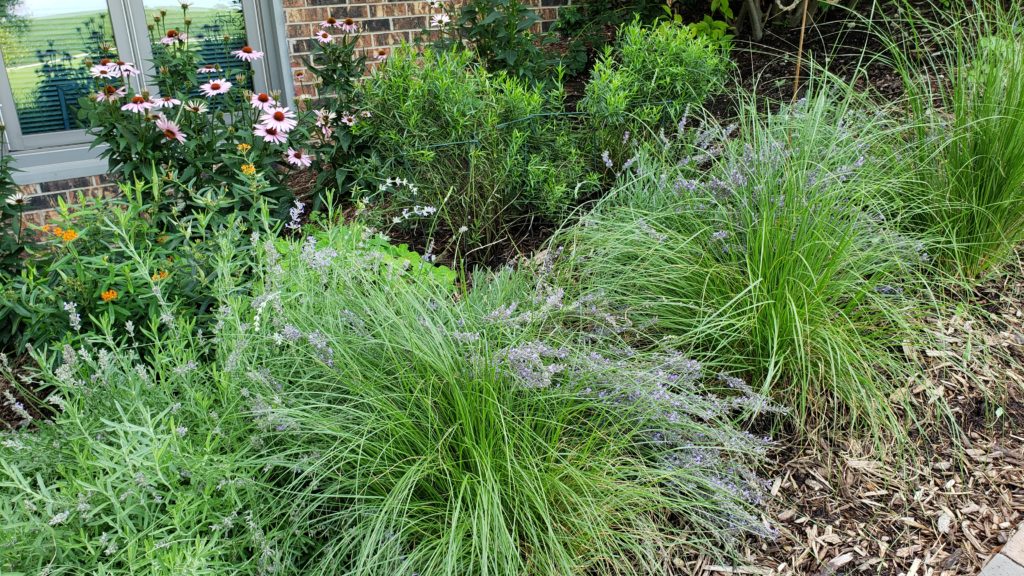Gardeners can have splashes of natural beauty in their landscape without tearing out what is there and starting all over. We value the beauty and pollination that butterflies and bees bring to our yards. We can have this without committing to an entirely native or prairie landscape.
 Pollinators will find the native plants in a garden, even when they are nestled among peonies, catmints, and roses. Two or three combinations placed around a yard attract native pollinators. Native plants provide the habitat bees and butterflies need: a place to live, find sustenance, and reproduce. A garden with native insects and plants will contribute to the diversity on our planet. With five clear steps, this article will help gardeners find a space to add a small habitat to their yards.
Pollinators will find the native plants in a garden, even when they are nestled among peonies, catmints, and roses. Two or three combinations placed around a yard attract native pollinators. Native plants provide the habitat bees and butterflies need: a place to live, find sustenance, and reproduce. A garden with native insects and plants will contribute to the diversity on our planet. With five clear steps, this article will help gardeners find a space to add a small habitat to their yards.
- Where. Identify places in your landscape that are bare or just need a spot of color and texture to liven up the design. View your yard from all angles. Is this a space that you see as you pull into your driveway or sit on your porch? Measure the available area.
- Site Conditions. Define the area as sunny, shady, or something in between. Is the soil sandy or claylike, or is it dark and crumbly?
- Existing Plants. What are the surrounding plants? When and for how long do they bloom and what are the colors? What are the shapes of the plants: creeping, round, spreading, tall? Try to use contrasting shapes with the new plants.
Choosing spots near spring and early summer blooming plants gives you an opportunity to use native plants to enhance the garden in the summer or fall after the early bloomers have finished.

- New Plants. This is the fun part. As always when choosing plants, know their hardiness zone. Many species have varieties that live in more than one zone. Also, know the conditions where they will thrive. In general, native plants need lean soil. The plants in this article prefer dry to medium soils and full to partial sun.
- Future. Maintenance of a habitat garden is easy. Water the first year and keep weeded. Fertilize sparingly, if at all. Deadhead and cut back only when the spent plants have deteriorated to the point that they are providing no interest in the winter garden. The seed heads provide food all winter for birds and the stems and leaf litter provide a place for bees and caterpillars to hide over the winter. Resist raking out and shredding the debris until the insects have emerged in the spring.
If you need assistance planning your garden, and tracking when your natives will bloom, the Hortisketch garden planner is the perfect solution. Hortisketch not only helps you plan your garden, but it’s dynamic growing calendar takes all the guess work out of when it’s time to sow, grow, and bloom!
Native Plants
Here are some favorite native plants for the garden with their common and botanical names. These are perennials, meaning they return each year from the same plant. Annuals last one season and grow from seeds each year. Some plants that are perennials in southern states are annuals in northern states. Always check the botanical name because common names often refer to more than one plant. Find resources in your area, such as garden centers, state extension offices, and botanical gardens to help you choose plants appropriate to where you live. You can always check trusted sites like Garden Savvy’s Plant Information section about these and other plants.

Native Perennials
- Mealy Blue Sage, Salvia farinacea, grows to 1-3 feet high, blooms May-frost, zones 8-10
Pitcher’s Sage, Salvia azurea, grows to 3-5 feet high, blooms July-October, zones 5-9
- Purple Coneflower, Echinacea purpurea, grows to 2-5 feet high, blooms April-June in south and June-August in the north, Zones 3-8
- Gayfeather, Liatris spicata, grows 2-3 feet high, blooms August-December in the south and July-August in the north, zones 3-8, likes a moister soil
- Butterflyweed, Asclepias tuberosa, grows to 1-2 ½ feet high, blooms June-August, zones 3-9
- Lanceleaf Coreopsis, Coreopsis lanceolata, grows to 1-2 feet high, blooms May-July, zones 4-9
Native Grasses
- Prairie Dropseed, Sporobolus heterolepis, grows to 1 ½ – 3 feet, blooms August-October, zones 3-9
- Pink Muhly Grass, Muhlenbergia capillaris, grows 4-9 feet high, blooms September-November, zones 5-10
About the Author:
Judy Nauseef is a freelance writer, landscape designer, and speaker specializing in sustainability and gardening with climate change. She writes about native plants, habitat gardens, prairie designs, stormwater management, travel, and all kinds of gardens. She is author of the book Gardening with Native Plants in the Upper Midwest: Bringing the Tallgrass Prairie Home. Her blog and newsletters can be found at https://judynauseef.com

Recent Posts
- Smart Gardening: How Technology Is Revolutionizing Horticulture
- Understanding Gardening Zones: What You Need to Know
- The Right Tools For Your Gardening And Landscaping Needs
- Maximizing Your Harvest: Square Foot Gardening Chart for Beginners
- Holiday Garden Scents: Plants for Natural Aromatherapy in Your Home






